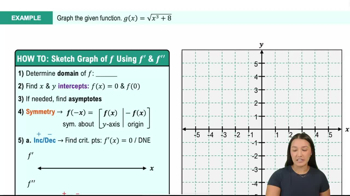Table of contents
- 0. Functions7h 52m
- Introduction to Functions16m
- Piecewise Functions10m
- Properties of Functions9m
- Common Functions1h 8m
- Transformations5m
- Combining Functions27m
- Exponent rules32m
- Exponential Functions28m
- Logarithmic Functions24m
- Properties of Logarithms34m
- Exponential & Logarithmic Equations35m
- Introduction to Trigonometric Functions38m
- Graphs of Trigonometric Functions44m
- Trigonometric Identities47m
- Inverse Trigonometric Functions48m
- 1. Limits and Continuity2h 2m
- 2. Intro to Derivatives1h 33m
- 3. Techniques of Differentiation3h 18m
- 4. Applications of Derivatives2h 38m
- 5. Graphical Applications of Derivatives6h 2m
- 6. Derivatives of Inverse, Exponential, & Logarithmic Functions2h 37m
- 7. Antiderivatives & Indefinite Integrals1h 26m
- 8. Definite Integrals4h 44m
- 9. Graphical Applications of Integrals2h 27m
- 10. Physics Applications of Integrals 2h 22m
5. Graphical Applications of Derivatives
Curve Sketching
Problem 3.6.59b
Textbook Question
{Use of Tech} Bungee jumper A woman attached to a bungee cord jumps from a bridge that is 30 m above a river. Her height in meters above the river t seconds after the jump is y(t) = 15(1+e^−t cos t), for t ≥ 0.
b. Use a graphing utility to determine when she is moving downward and when she is moving upward during the first 10 s.
 Verified step by step guidance
Verified step by step guidance1
To determine when the woman is moving downward or upward, we need to analyze the velocity of her motion. The velocity is the derivative of her height function y(t) with respect to time t.
Calculate the derivative y'(t) of the function y(t) = 15(1 + e^(-t) cos(t)). Use the product rule and chain rule for differentiation. The product rule states that if you have a function u(t)v(t), its derivative is u'(t)v(t) + u(t)v'(t).
Apply the product rule to the term e^(-t) cos(t). Let u(t) = e^(-t) and v(t) = cos(t). Then, u'(t) = -e^(-t) and v'(t) = -sin(t). The derivative of e^(-t) cos(t) is u'(t)v(t) + u(t)v'(t) = -e^(-t) cos(t) - e^(-t) sin(t).
Substitute the derivative back into the expression for y'(t): y'(t) = 15(0 + [-e^(-t) cos(t) - e^(-t) sin(t)]). Simplify this to get y'(t) = -15e^(-t)(cos(t) + sin(t)).
Use a graphing utility to plot y'(t) over the interval from t = 0 to t = 10 seconds. The woman is moving downward when y'(t) < 0 and moving upward when y'(t) > 0. Identify these intervals on the graph.
 Verified video answer for a similar problem:
Verified video answer for a similar problem:This video solution was recommended by our tutors as helpful for the problem above
Video duration:
2mPlay a video:
Was this helpful?
Key Concepts
Here are the essential concepts you must grasp in order to answer the question correctly.
Differentiation
Differentiation is a fundamental concept in calculus that involves finding the derivative of a function. The derivative represents the rate of change of the function with respect to its variable, which in this case is time. By differentiating the height function y(t), we can determine the velocity of the bungee jumper, indicating whether she is moving upward or downward based on the sign of the derivative.
Recommended video:

Finding Differentials
Critical Points
Critical points occur where the derivative of a function is zero or undefined. These points are essential for analyzing the behavior of the function, as they can indicate local maxima, minima, or points of inflection. In the context of the bungee jumper's height function, identifying critical points will help determine when her velocity changes from positive to negative, indicating a transition from upward to downward movement.
Recommended video:

Critical Points
Graphing Utilities
Graphing utilities are software tools that allow users to visualize mathematical functions and their behaviors. They can plot functions, calculate derivatives, and analyze critical points graphically. In this scenario, using a graphing utility will help visualize the height function y(t) over time, making it easier to identify intervals where the bungee jumper is moving upward or downward during the first 10 seconds of her jump.
Recommended video:

Graphing The Derivative

 11:41m
11:41mWatch next
Master Summary of Curve Sketching with a bite sized video explanation from Callie
Start learning




